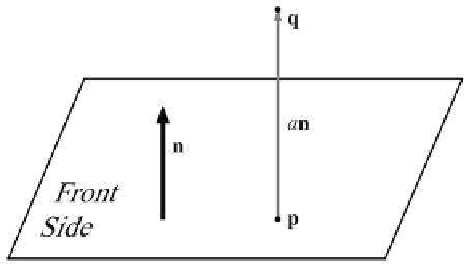Game Development Reference
In-Depth Information
/ /
Next
v e r t e x ,
p l e a s e
p
=
c ;
}
/ /
Normalize
t h e
r e s u l t
and
r e t u r n
i t
r e s u l t . n o r m a l i z e ( ) ;
r e t u r n
r e s u l t ;
}
Listing 9.5
Computing the best-fit plane normal for a set of points
The best-fit d value can be computed as the average of the d values for
each point:
n
n
d =
1
n
n
) =
1
n
(
p
i
p
i
n
.
Computing the best-fit
plane d value
i=1
i=1
9.5.4
Distance from Point to Plane
It is often the case that we have a plane and a point
q
that is not in the
plane, and we want to calculate the distance from the plane to
q
, or at
least classify
q
as being on the front or back side of the plane. To do this,
we imagine the point
p
that lies in the plane and is the closest point in the
plane to
q
. Clearly, the vector from
p
to
q
is perpendicular to the plane,
and thus is of the form a
n
, as shown in Figure 9.14.
Figure 9.14
Computing the
distance between a
point and a plane
If we assume the plane normal
n
is a unit vector, then the distance
from
p
to
q
(and thus the distance from the plane to
q
) is simply a. This
is a signed distance, which means that it will be negative when
q
is on the
back side of the plane. What's surprising is that we can compute a without
knowing the location of
p
. We go back to our original definition of
q
and
then perform some vector algebra to eliminate
p
:










Search WWH ::

Custom Search